Biochemistry Report on Nephron Function, Urine Formation, and Diseases
VerifiedAdded on 2023/06/13
|14
|4166
|277
Report
AI Summary
This report provides a detailed overview of the nephron's structure and function, highlighting its role as the functional unit of the kidney. It explores the processes of urine formation, including glomerular filtration, reabsorption, and secretion, and discusses the hormonal regulation of kidney function. The report also examines several kidney diseases such as glomerulonephritis, tubular acidosis, renal calculi, and diabetic nephropathy, detailing their causes, symptoms, and potential complications. The document emphasizes the importance of understanding these processes for diagnosing and managing kidney-related health issues.
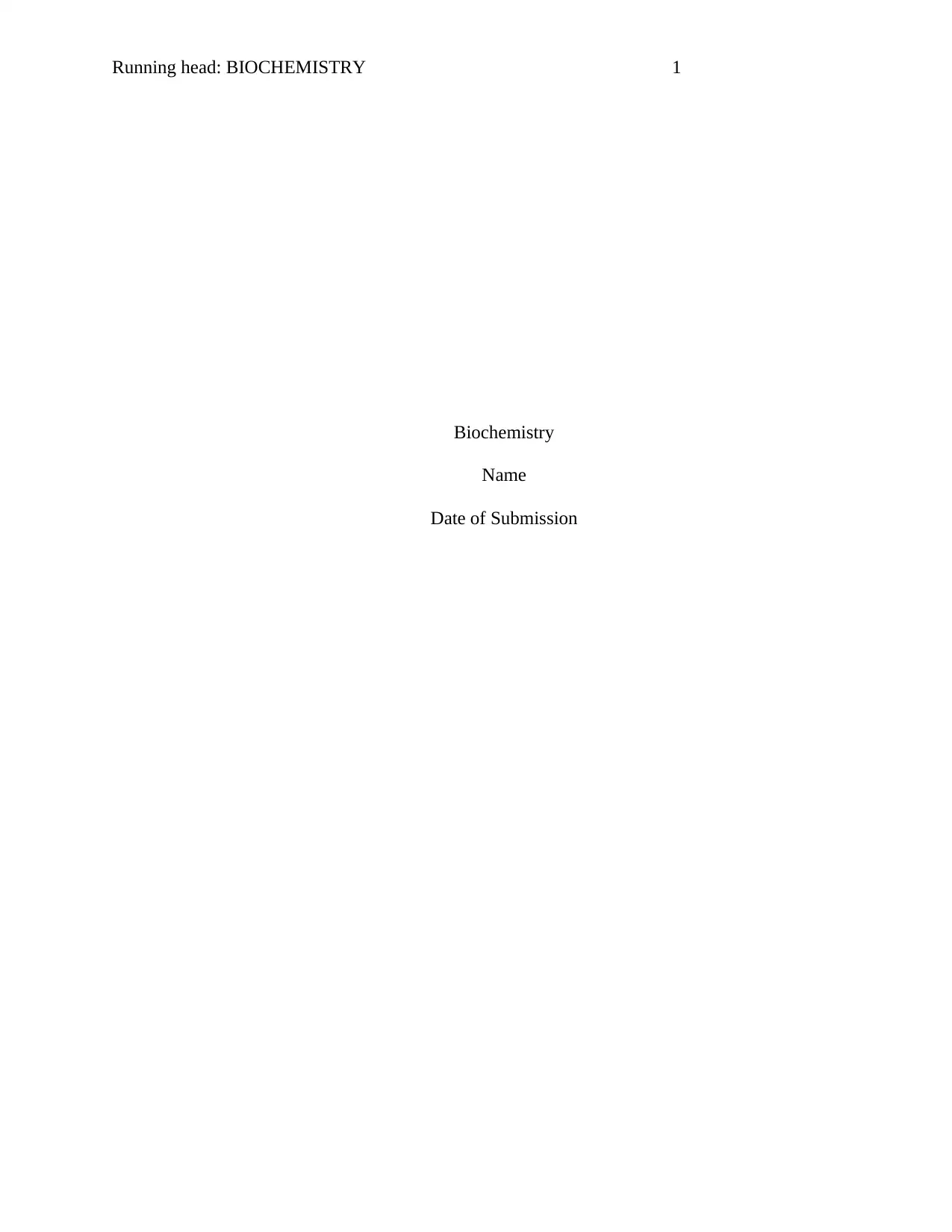
Running head: BIOCHEMISTRY 1
Biochemistry
Name
Date of Submission
Biochemistry
Name
Date of Submission
Paraphrase This Document
Need a fresh take? Get an instant paraphrase of this document with our AI Paraphraser
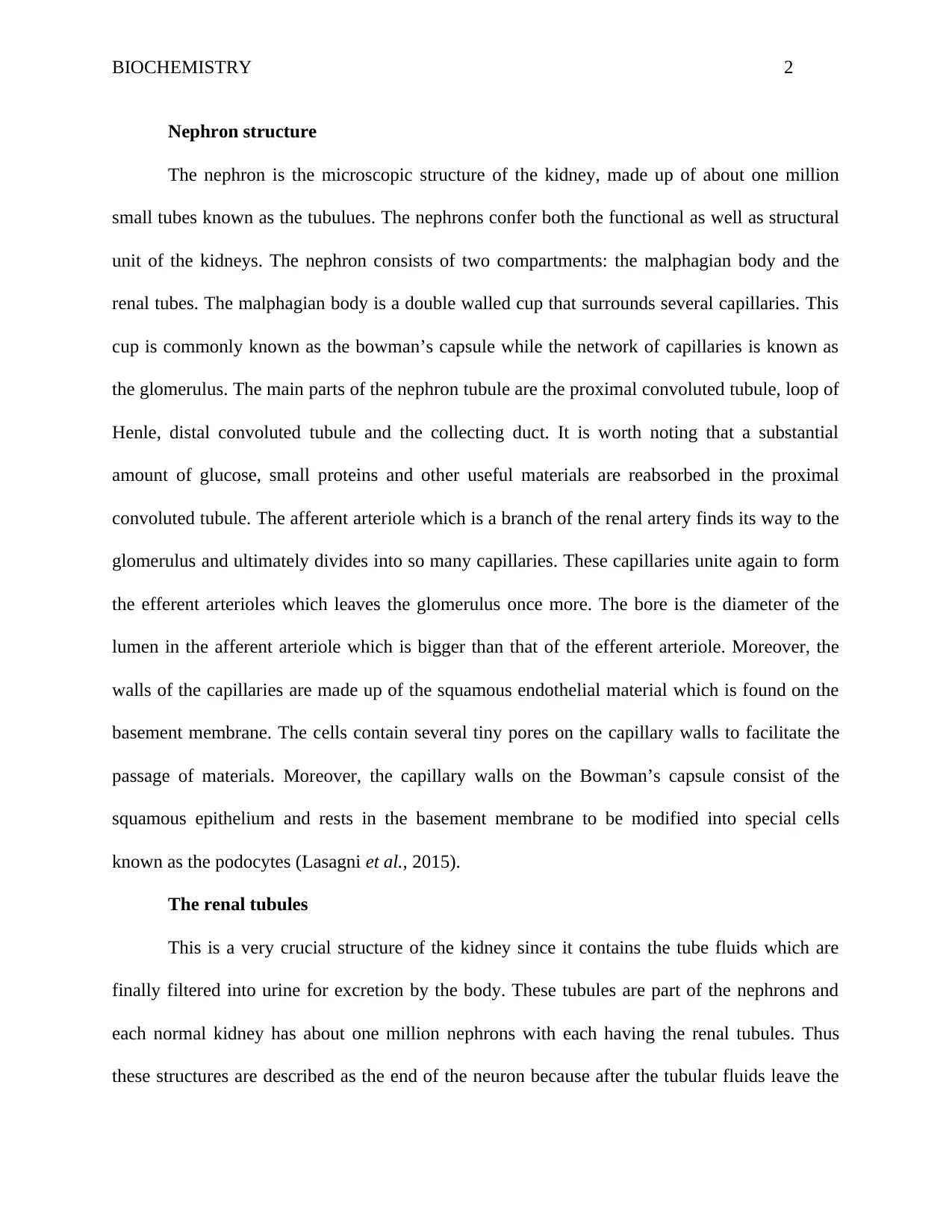
BIOCHEMISTRY 2
Nephron structure
The nephron is the microscopic structure of the kidney, made up of about one million
small tubes known as the tubulues. The nephrons confer both the functional as well as structural
unit of the kidneys. The nephron consists of two compartments: the malphagian body and the
renal tubes. The malphagian body is a double walled cup that surrounds several capillaries. This
cup is commonly known as the bowman’s capsule while the network of capillaries is known as
the glomerulus. The main parts of the nephron tubule are the proximal convoluted tubule, loop of
Henle, distal convoluted tubule and the collecting duct. It is worth noting that a substantial
amount of glucose, small proteins and other useful materials are reabsorbed in the proximal
convoluted tubule. The afferent arteriole which is a branch of the renal artery finds its way to the
glomerulus and ultimately divides into so many capillaries. These capillaries unite again to form
the efferent arterioles which leaves the glomerulus once more. The bore is the diameter of the
lumen in the afferent arteriole which is bigger than that of the efferent arteriole. Moreover, the
walls of the capillaries are made up of the squamous endothelial material which is found on the
basement membrane. The cells contain several tiny pores on the capillary walls to facilitate the
passage of materials. Moreover, the capillary walls on the Bowman’s capsule consist of the
squamous epithelium and rests in the basement membrane to be modified into special cells
known as the podocytes (Lasagni et al., 2015).
The renal tubules
This is a very crucial structure of the kidney since it contains the tube fluids which are
finally filtered into urine for excretion by the body. These tubules are part of the nephrons and
each normal kidney has about one million nephrons with each having the renal tubules. Thus
these structures are described as the end of the neuron because after the tubular fluids leave the
Nephron structure
The nephron is the microscopic structure of the kidney, made up of about one million
small tubes known as the tubulues. The nephrons confer both the functional as well as structural
unit of the kidneys. The nephron consists of two compartments: the malphagian body and the
renal tubes. The malphagian body is a double walled cup that surrounds several capillaries. This
cup is commonly known as the bowman’s capsule while the network of capillaries is known as
the glomerulus. The main parts of the nephron tubule are the proximal convoluted tubule, loop of
Henle, distal convoluted tubule and the collecting duct. It is worth noting that a substantial
amount of glucose, small proteins and other useful materials are reabsorbed in the proximal
convoluted tubule. The afferent arteriole which is a branch of the renal artery finds its way to the
glomerulus and ultimately divides into so many capillaries. These capillaries unite again to form
the efferent arterioles which leaves the glomerulus once more. The bore is the diameter of the
lumen in the afferent arteriole which is bigger than that of the efferent arteriole. Moreover, the
walls of the capillaries are made up of the squamous endothelial material which is found on the
basement membrane. The cells contain several tiny pores on the capillary walls to facilitate the
passage of materials. Moreover, the capillary walls on the Bowman’s capsule consist of the
squamous epithelium and rests in the basement membrane to be modified into special cells
known as the podocytes (Lasagni et al., 2015).
The renal tubules
This is a very crucial structure of the kidney since it contains the tube fluids which are
finally filtered into urine for excretion by the body. These tubules are part of the nephrons and
each normal kidney has about one million nephrons with each having the renal tubules. Thus
these structures are described as the end of the neuron because after the tubular fluids leave the
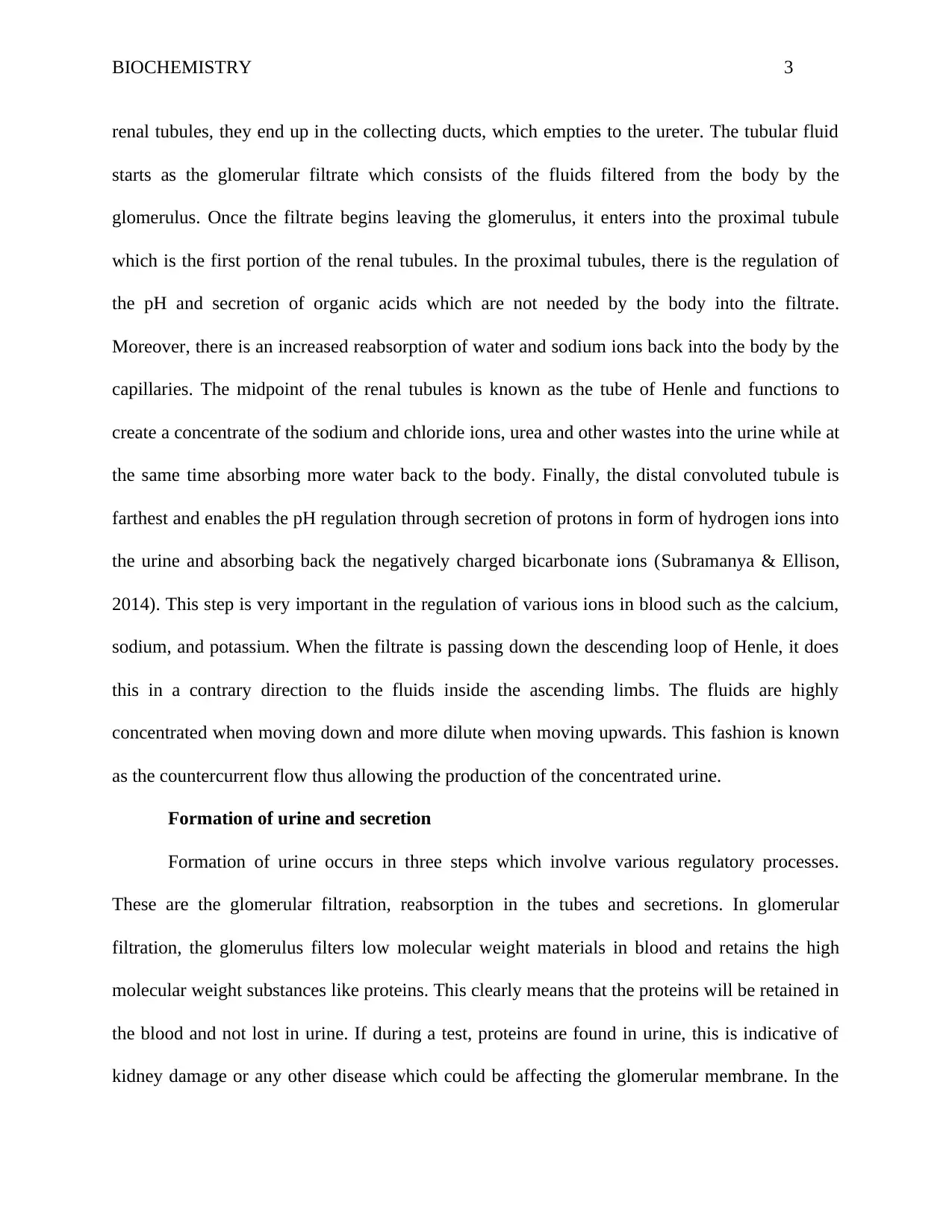
BIOCHEMISTRY 3
renal tubules, they end up in the collecting ducts, which empties to the ureter. The tubular fluid
starts as the glomerular filtrate which consists of the fluids filtered from the body by the
glomerulus. Once the filtrate begins leaving the glomerulus, it enters into the proximal tubule
which is the first portion of the renal tubules. In the proximal tubules, there is the regulation of
the pH and secretion of organic acids which are not needed by the body into the filtrate.
Moreover, there is an increased reabsorption of water and sodium ions back into the body by the
capillaries. The midpoint of the renal tubules is known as the tube of Henle and functions to
create a concentrate of the sodium and chloride ions, urea and other wastes into the urine while at
the same time absorbing more water back to the body. Finally, the distal convoluted tubule is
farthest and enables the pH regulation through secretion of protons in form of hydrogen ions into
the urine and absorbing back the negatively charged bicarbonate ions (Subramanya & Ellison,
2014). This step is very important in the regulation of various ions in blood such as the calcium,
sodium, and potassium. When the filtrate is passing down the descending loop of Henle, it does
this in a contrary direction to the fluids inside the ascending limbs. The fluids are highly
concentrated when moving down and more dilute when moving upwards. This fashion is known
as the countercurrent flow thus allowing the production of the concentrated urine.
Formation of urine and secretion
Formation of urine occurs in three steps which involve various regulatory processes.
These are the glomerular filtration, reabsorption in the tubes and secretions. In glomerular
filtration, the glomerulus filters low molecular weight materials in blood and retains the high
molecular weight substances like proteins. This clearly means that the proteins will be retained in
the blood and not lost in urine. If during a test, proteins are found in urine, this is indicative of
kidney damage or any other disease which could be affecting the glomerular membrane. In the
renal tubules, they end up in the collecting ducts, which empties to the ureter. The tubular fluid
starts as the glomerular filtrate which consists of the fluids filtered from the body by the
glomerulus. Once the filtrate begins leaving the glomerulus, it enters into the proximal tubule
which is the first portion of the renal tubules. In the proximal tubules, there is the regulation of
the pH and secretion of organic acids which are not needed by the body into the filtrate.
Moreover, there is an increased reabsorption of water and sodium ions back into the body by the
capillaries. The midpoint of the renal tubules is known as the tube of Henle and functions to
create a concentrate of the sodium and chloride ions, urea and other wastes into the urine while at
the same time absorbing more water back to the body. Finally, the distal convoluted tubule is
farthest and enables the pH regulation through secretion of protons in form of hydrogen ions into
the urine and absorbing back the negatively charged bicarbonate ions (Subramanya & Ellison,
2014). This step is very important in the regulation of various ions in blood such as the calcium,
sodium, and potassium. When the filtrate is passing down the descending loop of Henle, it does
this in a contrary direction to the fluids inside the ascending limbs. The fluids are highly
concentrated when moving down and more dilute when moving upwards. This fashion is known
as the countercurrent flow thus allowing the production of the concentrated urine.
Formation of urine and secretion
Formation of urine occurs in three steps which involve various regulatory processes.
These are the glomerular filtration, reabsorption in the tubes and secretions. In glomerular
filtration, the glomerulus filters low molecular weight materials in blood and retains the high
molecular weight substances like proteins. This clearly means that the proteins will be retained in
the blood and not lost in urine. If during a test, proteins are found in urine, this is indicative of
kidney damage or any other disease which could be affecting the glomerular membrane. In the
⊘ This is a preview!⊘
Do you want full access?
Subscribe today to unlock all pages.

Trusted by 1+ million students worldwide

BIOCHEMISTRY 4
reabsorption stage, even though the filtrate in the glomerulus has the same concentration of
glucose as the plasma, none of it is found in urine (Dantzler, 2016). Therefore, glucose should be
completely reabsorbed inside the tubules when the sugar concentrations are normal. Basically,
reabsorption of materials is dependent on the renal threshold of the materials inside. Different
solid materials get reabsorbed at various sites of the renal tubules. Glucose, amino acids and
small proteins can pass through the glomerulus and hence their absorptions occurs in the first
portion of the proximal tubules. On the other hand, bicarbonates, sodium and chlorides get
absorbed in a uniform manner along all parts of the proximal and distal tubules. However,
potassium ions are reabsorbed in the proximal tubules and later get secreted in the distal tubules.
Even though majority of materials are reabsorbed in the tubules, there are others which
are actively transported and excreted in the lumen of the tubules. In the tubules of man, majority
of the materials which are secreted are creatinine and potassium ions. It is at these sites that the
foreign materials such as diagnostic and therapeutic that have been introduced get removed
through urine.
Hormonal regulation of the kidneys
For the kidneys to function well, the interplay of three hormones is needed. These
hormones include the adrenal cortex hormone, vasopressin and parathormone. The aldosterone
hormone is involved in the excretion of sodium ions and potassium ions. The parathormone
stimulates the secretion of phosphates while vasopressin is an antidiuretic hormone which
facilitates the reabsorption of water. In the vent that the vasopressin hormone is absent, then
there will be production of high amounts of dilute hormone.
reabsorption stage, even though the filtrate in the glomerulus has the same concentration of
glucose as the plasma, none of it is found in urine (Dantzler, 2016). Therefore, glucose should be
completely reabsorbed inside the tubules when the sugar concentrations are normal. Basically,
reabsorption of materials is dependent on the renal threshold of the materials inside. Different
solid materials get reabsorbed at various sites of the renal tubules. Glucose, amino acids and
small proteins can pass through the glomerulus and hence their absorptions occurs in the first
portion of the proximal tubules. On the other hand, bicarbonates, sodium and chlorides get
absorbed in a uniform manner along all parts of the proximal and distal tubules. However,
potassium ions are reabsorbed in the proximal tubules and later get secreted in the distal tubules.
Even though majority of materials are reabsorbed in the tubules, there are others which
are actively transported and excreted in the lumen of the tubules. In the tubules of man, majority
of the materials which are secreted are creatinine and potassium ions. It is at these sites that the
foreign materials such as diagnostic and therapeutic that have been introduced get removed
through urine.
Hormonal regulation of the kidneys
For the kidneys to function well, the interplay of three hormones is needed. These
hormones include the adrenal cortex hormone, vasopressin and parathormone. The aldosterone
hormone is involved in the excretion of sodium ions and potassium ions. The parathormone
stimulates the secretion of phosphates while vasopressin is an antidiuretic hormone which
facilitates the reabsorption of water. In the vent that the vasopressin hormone is absent, then
there will be production of high amounts of dilute hormone.
Paraphrase This Document
Need a fresh take? Get an instant paraphrase of this document with our AI Paraphraser
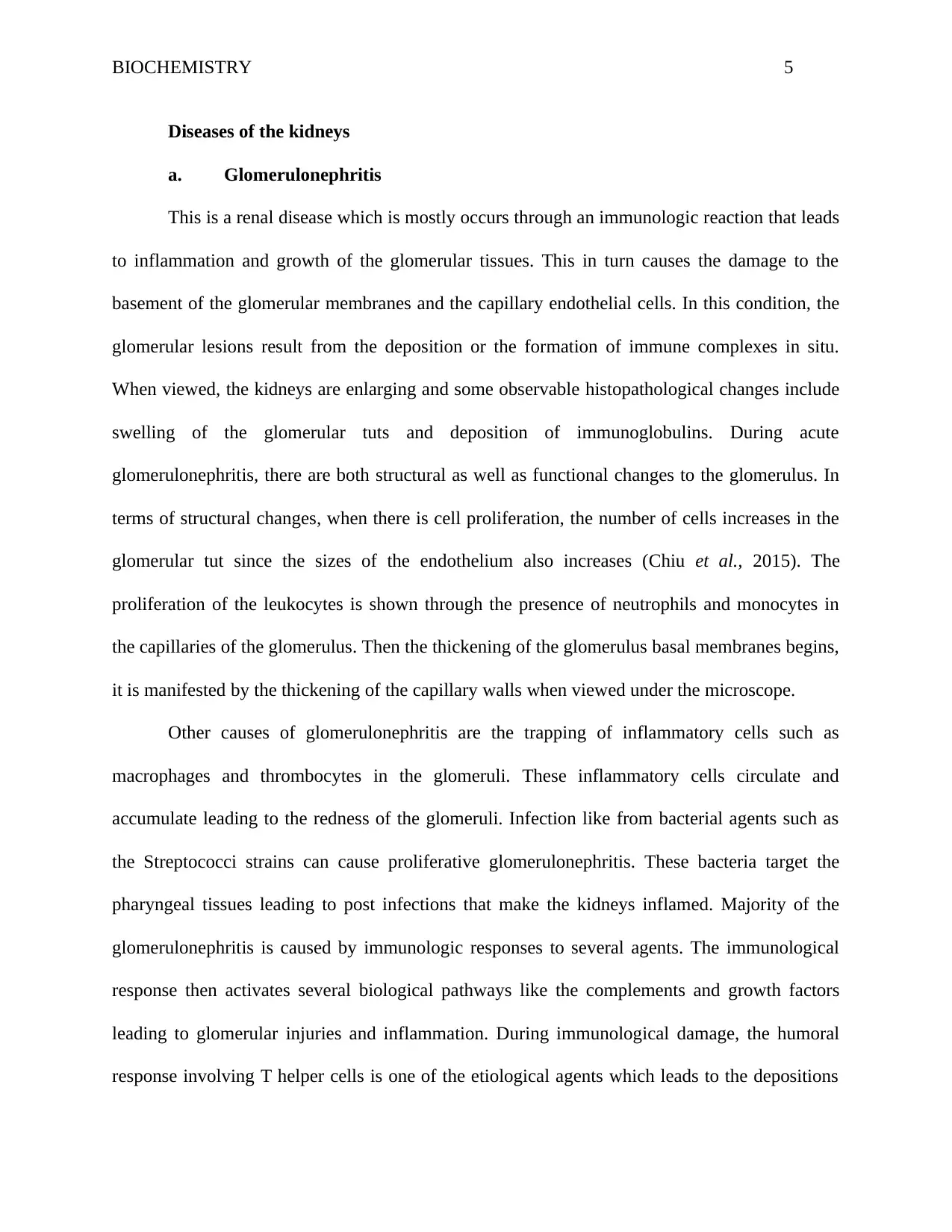
BIOCHEMISTRY 5
Diseases of the kidneys
a. Glomerulonephritis
This is a renal disease which is mostly occurs through an immunologic reaction that leads
to inflammation and growth of the glomerular tissues. This in turn causes the damage to the
basement of the glomerular membranes and the capillary endothelial cells. In this condition, the
glomerular lesions result from the deposition or the formation of immune complexes in situ.
When viewed, the kidneys are enlarging and some observable histopathological changes include
swelling of the glomerular tuts and deposition of immunoglobulins. During acute
glomerulonephritis, there are both structural as well as functional changes to the glomerulus. In
terms of structural changes, when there is cell proliferation, the number of cells increases in the
glomerular tut since the sizes of the endothelium also increases (Chiu et al., 2015). The
proliferation of the leukocytes is shown through the presence of neutrophils and monocytes in
the capillaries of the glomerulus. Then the thickening of the glomerulus basal membranes begins,
it is manifested by the thickening of the capillary walls when viewed under the microscope.
Other causes of glomerulonephritis are the trapping of inflammatory cells such as
macrophages and thrombocytes in the glomeruli. These inflammatory cells circulate and
accumulate leading to the redness of the glomeruli. Infection like from bacterial agents such as
the Streptococci strains can cause proliferative glomerulonephritis. These bacteria target the
pharyngeal tissues leading to post infections that make the kidneys inflamed. Majority of the
glomerulonephritis is caused by immunologic responses to several agents. The immunological
response then activates several biological pathways like the complements and growth factors
leading to glomerular injuries and inflammation. During immunological damage, the humoral
response involving T helper cells is one of the etiological agents which leads to the depositions
Diseases of the kidneys
a. Glomerulonephritis
This is a renal disease which is mostly occurs through an immunologic reaction that leads
to inflammation and growth of the glomerular tissues. This in turn causes the damage to the
basement of the glomerular membranes and the capillary endothelial cells. In this condition, the
glomerular lesions result from the deposition or the formation of immune complexes in situ.
When viewed, the kidneys are enlarging and some observable histopathological changes include
swelling of the glomerular tuts and deposition of immunoglobulins. During acute
glomerulonephritis, there are both structural as well as functional changes to the glomerulus. In
terms of structural changes, when there is cell proliferation, the number of cells increases in the
glomerular tut since the sizes of the endothelium also increases (Chiu et al., 2015). The
proliferation of the leukocytes is shown through the presence of neutrophils and monocytes in
the capillaries of the glomerulus. Then the thickening of the glomerulus basal membranes begins,
it is manifested by the thickening of the capillary walls when viewed under the microscope.
Other causes of glomerulonephritis are the trapping of inflammatory cells such as
macrophages and thrombocytes in the glomeruli. These inflammatory cells circulate and
accumulate leading to the redness of the glomeruli. Infection like from bacterial agents such as
the Streptococci strains can cause proliferative glomerulonephritis. These bacteria target the
pharyngeal tissues leading to post infections that make the kidneys inflamed. Majority of the
glomerulonephritis is caused by immunologic responses to several agents. The immunological
response then activates several biological pathways like the complements and growth factors
leading to glomerular injuries and inflammation. During immunological damage, the humoral
response involving T helper cells is one of the etiological agents which leads to the depositions
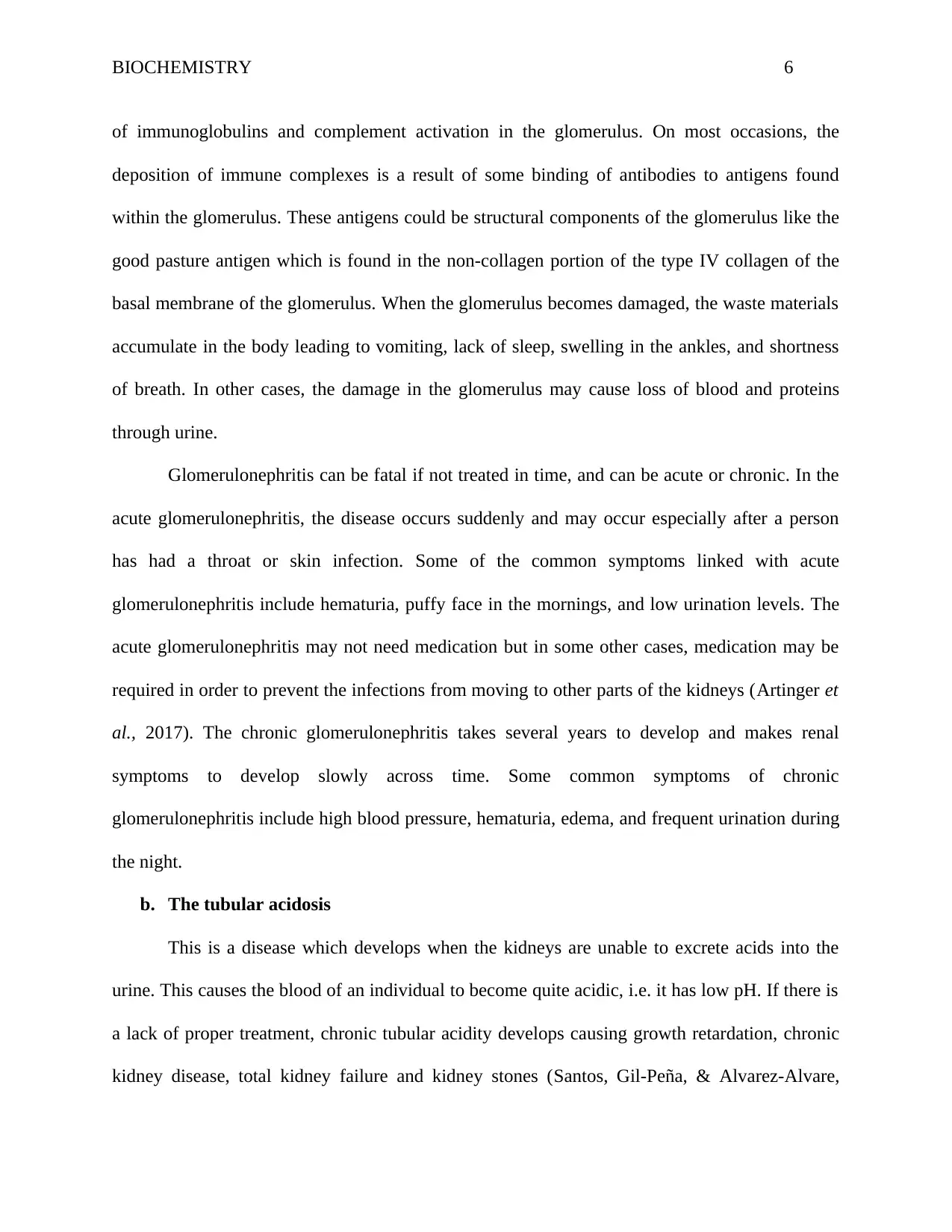
BIOCHEMISTRY 6
of immunoglobulins and complement activation in the glomerulus. On most occasions, the
deposition of immune complexes is a result of some binding of antibodies to antigens found
within the glomerulus. These antigens could be structural components of the glomerulus like the
good pasture antigen which is found in the non-collagen portion of the type IV collagen of the
basal membrane of the glomerulus. When the glomerulus becomes damaged, the waste materials
accumulate in the body leading to vomiting, lack of sleep, swelling in the ankles, and shortness
of breath. In other cases, the damage in the glomerulus may cause loss of blood and proteins
through urine.
Glomerulonephritis can be fatal if not treated in time, and can be acute or chronic. In the
acute glomerulonephritis, the disease occurs suddenly and may occur especially after a person
has had a throat or skin infection. Some of the common symptoms linked with acute
glomerulonephritis include hematuria, puffy face in the mornings, and low urination levels. The
acute glomerulonephritis may not need medication but in some other cases, medication may be
required in order to prevent the infections from moving to other parts of the kidneys (Artinger et
al., 2017). The chronic glomerulonephritis takes several years to develop and makes renal
symptoms to develop slowly across time. Some common symptoms of chronic
glomerulonephritis include high blood pressure, hematuria, edema, and frequent urination during
the night.
b. The tubular acidosis
This is a disease which develops when the kidneys are unable to excrete acids into the
urine. This causes the blood of an individual to become quite acidic, i.e. it has low pH. If there is
a lack of proper treatment, chronic tubular acidity develops causing growth retardation, chronic
kidney disease, total kidney failure and kidney stones (Santos, Gil-Peña, & Alvarez-Alvare,
of immunoglobulins and complement activation in the glomerulus. On most occasions, the
deposition of immune complexes is a result of some binding of antibodies to antigens found
within the glomerulus. These antigens could be structural components of the glomerulus like the
good pasture antigen which is found in the non-collagen portion of the type IV collagen of the
basal membrane of the glomerulus. When the glomerulus becomes damaged, the waste materials
accumulate in the body leading to vomiting, lack of sleep, swelling in the ankles, and shortness
of breath. In other cases, the damage in the glomerulus may cause loss of blood and proteins
through urine.
Glomerulonephritis can be fatal if not treated in time, and can be acute or chronic. In the
acute glomerulonephritis, the disease occurs suddenly and may occur especially after a person
has had a throat or skin infection. Some of the common symptoms linked with acute
glomerulonephritis include hematuria, puffy face in the mornings, and low urination levels. The
acute glomerulonephritis may not need medication but in some other cases, medication may be
required in order to prevent the infections from moving to other parts of the kidneys (Artinger et
al., 2017). The chronic glomerulonephritis takes several years to develop and makes renal
symptoms to develop slowly across time. Some common symptoms of chronic
glomerulonephritis include high blood pressure, hematuria, edema, and frequent urination during
the night.
b. The tubular acidosis
This is a disease which develops when the kidneys are unable to excrete acids into the
urine. This causes the blood of an individual to become quite acidic, i.e. it has low pH. If there is
a lack of proper treatment, chronic tubular acidity develops causing growth retardation, chronic
kidney disease, total kidney failure and kidney stones (Santos, Gil-Peña, & Alvarez-Alvare,
⊘ This is a preview!⊘
Do you want full access?
Subscribe today to unlock all pages.

Trusted by 1+ million students worldwide
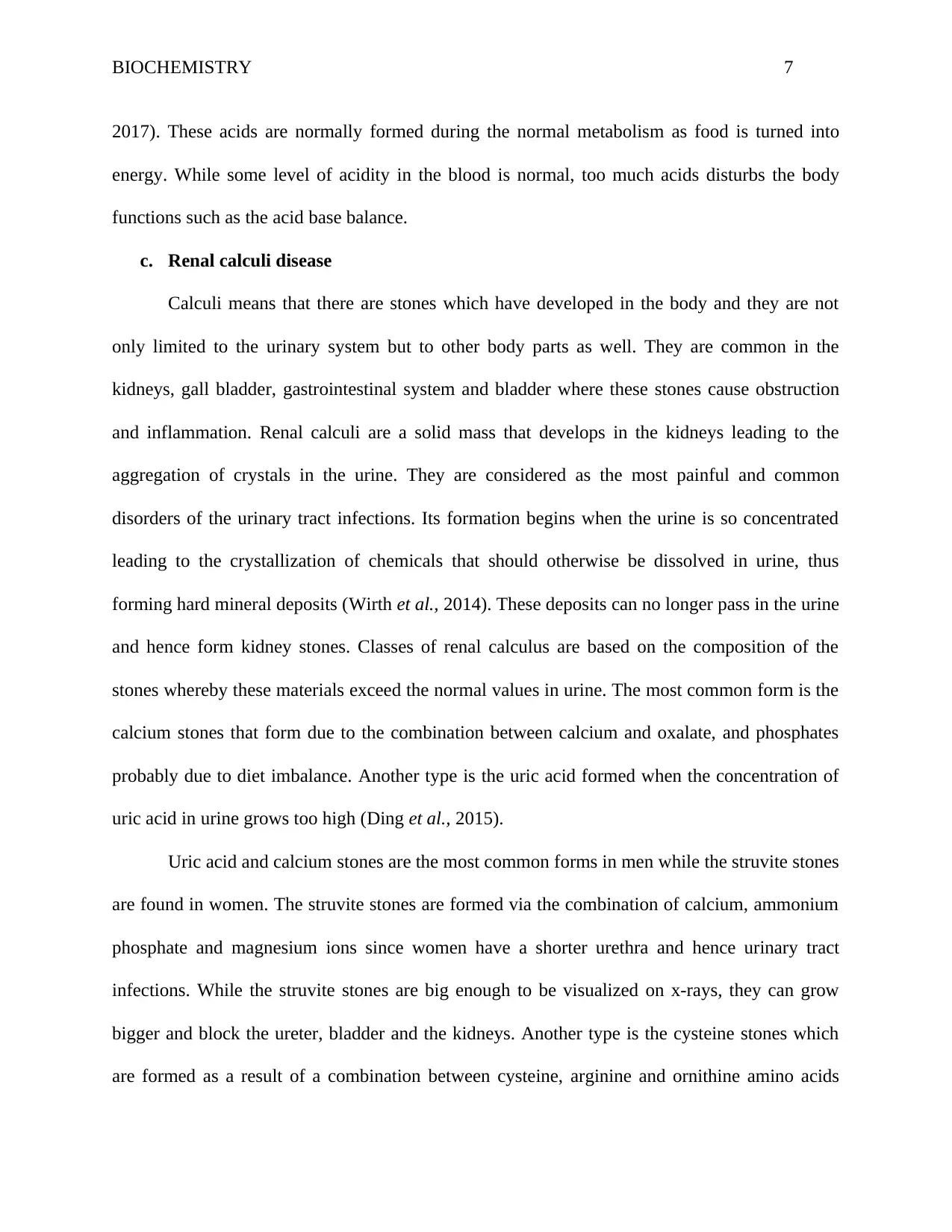
BIOCHEMISTRY 7
2017). These acids are normally formed during the normal metabolism as food is turned into
energy. While some level of acidity in the blood is normal, too much acids disturbs the body
functions such as the acid base balance.
c. Renal calculi disease
Calculi means that there are stones which have developed in the body and they are not
only limited to the urinary system but to other body parts as well. They are common in the
kidneys, gall bladder, gastrointestinal system and bladder where these stones cause obstruction
and inflammation. Renal calculi are a solid mass that develops in the kidneys leading to the
aggregation of crystals in the urine. They are considered as the most painful and common
disorders of the urinary tract infections. Its formation begins when the urine is so concentrated
leading to the crystallization of chemicals that should otherwise be dissolved in urine, thus
forming hard mineral deposits (Wirth et al., 2014). These deposits can no longer pass in the urine
and hence form kidney stones. Classes of renal calculus are based on the composition of the
stones whereby these materials exceed the normal values in urine. The most common form is the
calcium stones that form due to the combination between calcium and oxalate, and phosphates
probably due to diet imbalance. Another type is the uric acid formed when the concentration of
uric acid in urine grows too high (Ding et al., 2015).
Uric acid and calcium stones are the most common forms in men while the struvite stones
are found in women. The struvite stones are formed via the combination of calcium, ammonium
phosphate and magnesium ions since women have a shorter urethra and hence urinary tract
infections. While the struvite stones are big enough to be visualized on x-rays, they can grow
bigger and block the ureter, bladder and the kidneys. Another type is the cysteine stones which
are formed as a result of a combination between cysteine, arginine and ornithine amino acids
2017). These acids are normally formed during the normal metabolism as food is turned into
energy. While some level of acidity in the blood is normal, too much acids disturbs the body
functions such as the acid base balance.
c. Renal calculi disease
Calculi means that there are stones which have developed in the body and they are not
only limited to the urinary system but to other body parts as well. They are common in the
kidneys, gall bladder, gastrointestinal system and bladder where these stones cause obstruction
and inflammation. Renal calculi are a solid mass that develops in the kidneys leading to the
aggregation of crystals in the urine. They are considered as the most painful and common
disorders of the urinary tract infections. Its formation begins when the urine is so concentrated
leading to the crystallization of chemicals that should otherwise be dissolved in urine, thus
forming hard mineral deposits (Wirth et al., 2014). These deposits can no longer pass in the urine
and hence form kidney stones. Classes of renal calculus are based on the composition of the
stones whereby these materials exceed the normal values in urine. The most common form is the
calcium stones that form due to the combination between calcium and oxalate, and phosphates
probably due to diet imbalance. Another type is the uric acid formed when the concentration of
uric acid in urine grows too high (Ding et al., 2015).
Uric acid and calcium stones are the most common forms in men while the struvite stones
are found in women. The struvite stones are formed via the combination of calcium, ammonium
phosphate and magnesium ions since women have a shorter urethra and hence urinary tract
infections. While the struvite stones are big enough to be visualized on x-rays, they can grow
bigger and block the ureter, bladder and the kidneys. Another type is the cysteine stones which
are formed as a result of a combination between cysteine, arginine and ornithine amino acids
Paraphrase This Document
Need a fresh take? Get an instant paraphrase of this document with our AI Paraphraser
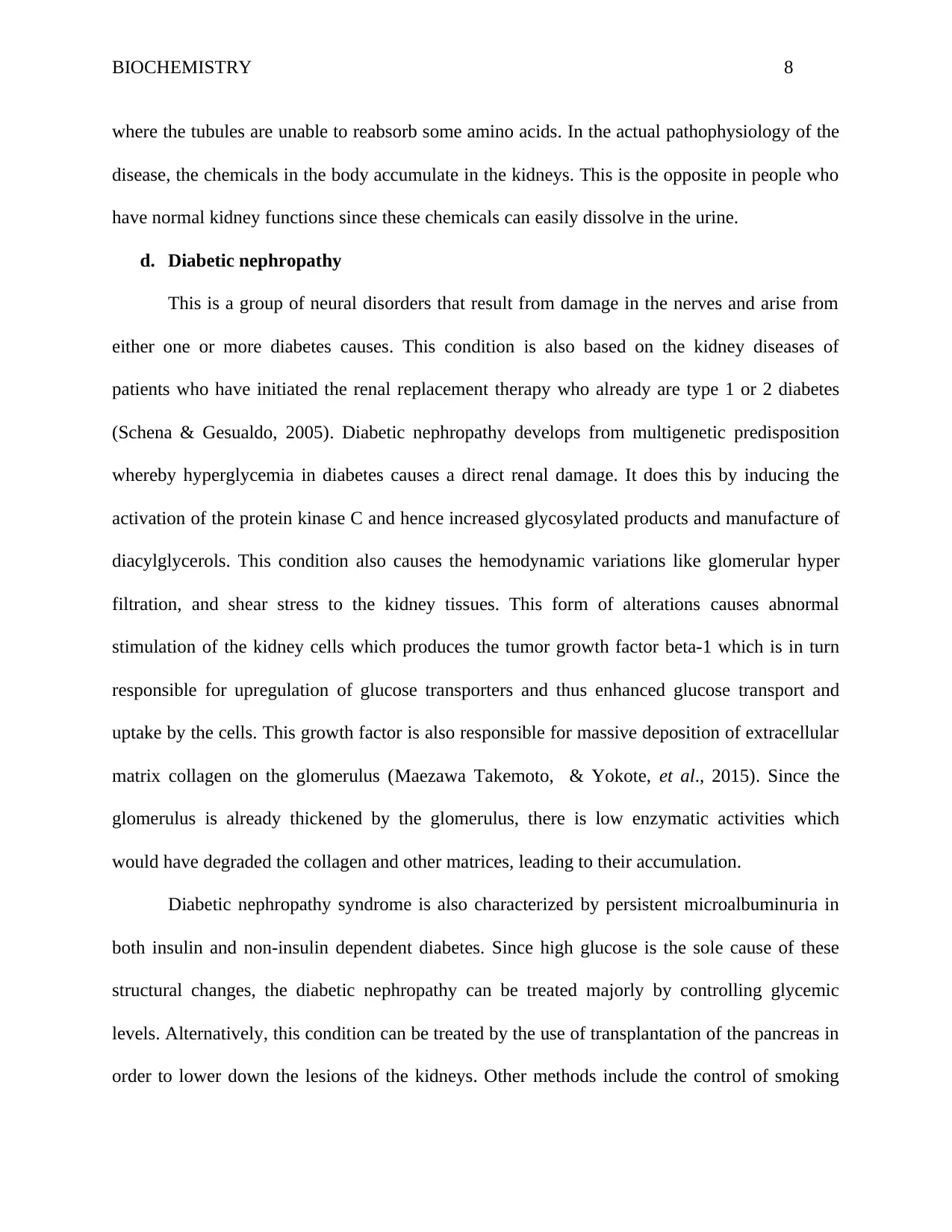
BIOCHEMISTRY 8
where the tubules are unable to reabsorb some amino acids. In the actual pathophysiology of the
disease, the chemicals in the body accumulate in the kidneys. This is the opposite in people who
have normal kidney functions since these chemicals can easily dissolve in the urine.
d. Diabetic nephropathy
This is a group of neural disorders that result from damage in the nerves and arise from
either one or more diabetes causes. This condition is also based on the kidney diseases of
patients who have initiated the renal replacement therapy who already are type 1 or 2 diabetes
(Schena & Gesualdo, 2005). Diabetic nephropathy develops from multigenetic predisposition
whereby hyperglycemia in diabetes causes a direct renal damage. It does this by inducing the
activation of the protein kinase C and hence increased glycosylated products and manufacture of
diacylglycerols. This condition also causes the hemodynamic variations like glomerular hyper
filtration, and shear stress to the kidney tissues. This form of alterations causes abnormal
stimulation of the kidney cells which produces the tumor growth factor beta-1 which is in turn
responsible for upregulation of glucose transporters and thus enhanced glucose transport and
uptake by the cells. This growth factor is also responsible for massive deposition of extracellular
matrix collagen on the glomerulus (Maezawa Takemoto, & Yokote, et al., 2015). Since the
glomerulus is already thickened by the glomerulus, there is low enzymatic activities which
would have degraded the collagen and other matrices, leading to their accumulation.
Diabetic nephropathy syndrome is also characterized by persistent microalbuminuria in
both insulin and non-insulin dependent diabetes. Since high glucose is the sole cause of these
structural changes, the diabetic nephropathy can be treated majorly by controlling glycemic
levels. Alternatively, this condition can be treated by the use of transplantation of the pancreas in
order to lower down the lesions of the kidneys. Other methods include the control of smoking
where the tubules are unable to reabsorb some amino acids. In the actual pathophysiology of the
disease, the chemicals in the body accumulate in the kidneys. This is the opposite in people who
have normal kidney functions since these chemicals can easily dissolve in the urine.
d. Diabetic nephropathy
This is a group of neural disorders that result from damage in the nerves and arise from
either one or more diabetes causes. This condition is also based on the kidney diseases of
patients who have initiated the renal replacement therapy who already are type 1 or 2 diabetes
(Schena & Gesualdo, 2005). Diabetic nephropathy develops from multigenetic predisposition
whereby hyperglycemia in diabetes causes a direct renal damage. It does this by inducing the
activation of the protein kinase C and hence increased glycosylated products and manufacture of
diacylglycerols. This condition also causes the hemodynamic variations like glomerular hyper
filtration, and shear stress to the kidney tissues. This form of alterations causes abnormal
stimulation of the kidney cells which produces the tumor growth factor beta-1 which is in turn
responsible for upregulation of glucose transporters and thus enhanced glucose transport and
uptake by the cells. This growth factor is also responsible for massive deposition of extracellular
matrix collagen on the glomerulus (Maezawa Takemoto, & Yokote, et al., 2015). Since the
glomerulus is already thickened by the glomerulus, there is low enzymatic activities which
would have degraded the collagen and other matrices, leading to their accumulation.
Diabetic nephropathy syndrome is also characterized by persistent microalbuminuria in
both insulin and non-insulin dependent diabetes. Since high glucose is the sole cause of these
structural changes, the diabetic nephropathy can be treated majorly by controlling glycemic
levels. Alternatively, this condition can be treated by the use of transplantation of the pancreas in
order to lower down the lesions of the kidneys. Other methods include the control of smoking

BIOCHEMISTRY 9
behaviors, lipids consumption controls and controlling the blood pressure. Early treatment of
glucose levels in the young adults who are suffering from diabetes has been found to increase the
survival rates (Gale et al., 2005). Concerning the pancreas transplant, in a study involving serial
renal biopsies Fioretto, Steffes, Sutherland, Goetz, & Mauer (1998) reported that following
pancreas transplant, the thickness of the glomerular membrane base reduced gradually in a
period of five to ten years.
Renal function/ biochemistry tests
a. Urinalysis
This tests makes a screening for the possible presence of blood and proteins in the urine.
Urinalysis can be used to screen for drug use, pregnancy, monitoring of glucose levels and
urinary system disease. Thus urinalysis is a method which is used to test for the physical,
chemical as well as microscopic analysis in any sample of urine from a patient. When testing for
physical parameters, normal urine is yellow in color because of the presence of uribilin.
However, abnormal urine appears dark orange, brown, red in color and has a cloudy appearance
(Schroeder, Chang, Shen, Biondi, & Greenhow, 2015). These physical changes could be due to
either presence of red or white blood cells. These abnormalities are indicative of abnormalities
like infections in the liver or kidneys. Specific gravity is one of the physical parameters, that is
the concentration of particles and solutes contained in the urine. High levels of specific gravity in
urine could indicate diarrheas, abnormal secretion of ADH hormone and glucose in urine and in
other cases renal failure. The chemical parameters in urine are tested using a dipstick which has a
plastic coated with some reagent. The dipstick color then changes based on the concentrations of
glucose, proteins and pH among many other parameters. The presence of bilirubin and blood
behaviors, lipids consumption controls and controlling the blood pressure. Early treatment of
glucose levels in the young adults who are suffering from diabetes has been found to increase the
survival rates (Gale et al., 2005). Concerning the pancreas transplant, in a study involving serial
renal biopsies Fioretto, Steffes, Sutherland, Goetz, & Mauer (1998) reported that following
pancreas transplant, the thickness of the glomerular membrane base reduced gradually in a
period of five to ten years.
Renal function/ biochemistry tests
a. Urinalysis
This tests makes a screening for the possible presence of blood and proteins in the urine.
Urinalysis can be used to screen for drug use, pregnancy, monitoring of glucose levels and
urinary system disease. Thus urinalysis is a method which is used to test for the physical,
chemical as well as microscopic analysis in any sample of urine from a patient. When testing for
physical parameters, normal urine is yellow in color because of the presence of uribilin.
However, abnormal urine appears dark orange, brown, red in color and has a cloudy appearance
(Schroeder, Chang, Shen, Biondi, & Greenhow, 2015). These physical changes could be due to
either presence of red or white blood cells. These abnormalities are indicative of abnormalities
like infections in the liver or kidneys. Specific gravity is one of the physical parameters, that is
the concentration of particles and solutes contained in the urine. High levels of specific gravity in
urine could indicate diarrheas, abnormal secretion of ADH hormone and glucose in urine and in
other cases renal failure. The chemical parameters in urine are tested using a dipstick which has a
plastic coated with some reagent. The dipstick color then changes based on the concentrations of
glucose, proteins and pH among many other parameters. The presence of bilirubin and blood
⊘ This is a preview!⊘
Do you want full access?
Subscribe today to unlock all pages.

Trusted by 1+ million students worldwide
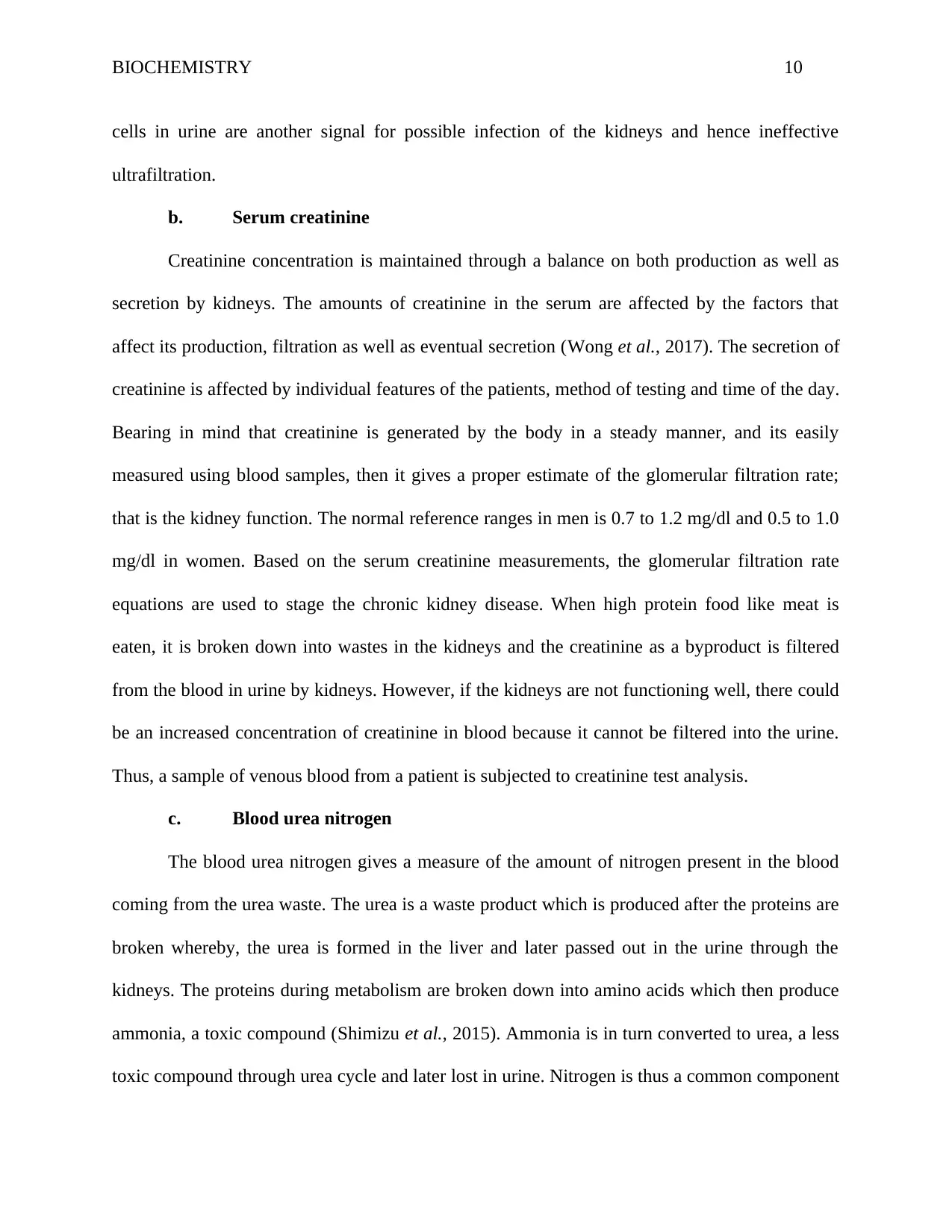
BIOCHEMISTRY 10
cells in urine are another signal for possible infection of the kidneys and hence ineffective
ultrafiltration.
b. Serum creatinine
Creatinine concentration is maintained through a balance on both production as well as
secretion by kidneys. The amounts of creatinine in the serum are affected by the factors that
affect its production, filtration as well as eventual secretion (Wong et al., 2017). The secretion of
creatinine is affected by individual features of the patients, method of testing and time of the day.
Bearing in mind that creatinine is generated by the body in a steady manner, and its easily
measured using blood samples, then it gives a proper estimate of the glomerular filtration rate;
that is the kidney function. The normal reference ranges in men is 0.7 to 1.2 mg/dl and 0.5 to 1.0
mg/dl in women. Based on the serum creatinine measurements, the glomerular filtration rate
equations are used to stage the chronic kidney disease. When high protein food like meat is
eaten, it is broken down into wastes in the kidneys and the creatinine as a byproduct is filtered
from the blood in urine by kidneys. However, if the kidneys are not functioning well, there could
be an increased concentration of creatinine in blood because it cannot be filtered into the urine.
Thus, a sample of venous blood from a patient is subjected to creatinine test analysis.
c. Blood urea nitrogen
The blood urea nitrogen gives a measure of the amount of nitrogen present in the blood
coming from the urea waste. The urea is a waste product which is produced after the proteins are
broken whereby, the urea is formed in the liver and later passed out in the urine through the
kidneys. The proteins during metabolism are broken down into amino acids which then produce
ammonia, a toxic compound (Shimizu et al., 2015). Ammonia is in turn converted to urea, a less
toxic compound through urea cycle and later lost in urine. Nitrogen is thus a common component
cells in urine are another signal for possible infection of the kidneys and hence ineffective
ultrafiltration.
b. Serum creatinine
Creatinine concentration is maintained through a balance on both production as well as
secretion by kidneys. The amounts of creatinine in the serum are affected by the factors that
affect its production, filtration as well as eventual secretion (Wong et al., 2017). The secretion of
creatinine is affected by individual features of the patients, method of testing and time of the day.
Bearing in mind that creatinine is generated by the body in a steady manner, and its easily
measured using blood samples, then it gives a proper estimate of the glomerular filtration rate;
that is the kidney function. The normal reference ranges in men is 0.7 to 1.2 mg/dl and 0.5 to 1.0
mg/dl in women. Based on the serum creatinine measurements, the glomerular filtration rate
equations are used to stage the chronic kidney disease. When high protein food like meat is
eaten, it is broken down into wastes in the kidneys and the creatinine as a byproduct is filtered
from the blood in urine by kidneys. However, if the kidneys are not functioning well, there could
be an increased concentration of creatinine in blood because it cannot be filtered into the urine.
Thus, a sample of venous blood from a patient is subjected to creatinine test analysis.
c. Blood urea nitrogen
The blood urea nitrogen gives a measure of the amount of nitrogen present in the blood
coming from the urea waste. The urea is a waste product which is produced after the proteins are
broken whereby, the urea is formed in the liver and later passed out in the urine through the
kidneys. The proteins during metabolism are broken down into amino acids which then produce
ammonia, a toxic compound (Shimizu et al., 2015). Ammonia is in turn converted to urea, a less
toxic compound through urea cycle and later lost in urine. Nitrogen is thus a common component
Paraphrase This Document
Need a fresh take? Get an instant paraphrase of this document with our AI Paraphraser

BIOCHEMISTRY 11
of ammonia and urea and hence the name of this biochemical test. Thus, the blood urea nitrogen
is done in order to determine how well the kidneys are functioning in the removal of urea from
the blood into urine. In the event that the kidneys are not working well, then blood urea levels
will be very high. The normal range values for blood urea nitrogen are 8 to 24 mg/dl in men and
6 to 21 mg/dl in women.
d. Glomerular filtration rate
This is a test which is commonly used to measure the level of kidney functions and hence
enables the staging of the kidney disease. The glomerular filtration rate test is calculated from the
measurement of age, blood creatinine, gender and body size. Once the stage of the kidney
disease is determined, the medical practitioners can then be able to make a proper treatment plan
(Wesson, Pruszynski, Cai, & Simoni, 2017). In the event that the glomerular filtration rate is
low, it means that the kidneys are not functioning well and hence the need for immediate
medications. While the normal values of this parameter is estimated as 90, there are other factors
like progressive aging which causes a decrease in this value even in the absence of a kidney
disease. Common symptoms of this condition are blood in urine, pain in the back near the
kidneys, swelling om the wrists and ankles and painful urination.
of ammonia and urea and hence the name of this biochemical test. Thus, the blood urea nitrogen
is done in order to determine how well the kidneys are functioning in the removal of urea from
the blood into urine. In the event that the kidneys are not working well, then blood urea levels
will be very high. The normal range values for blood urea nitrogen are 8 to 24 mg/dl in men and
6 to 21 mg/dl in women.
d. Glomerular filtration rate
This is a test which is commonly used to measure the level of kidney functions and hence
enables the staging of the kidney disease. The glomerular filtration rate test is calculated from the
measurement of age, blood creatinine, gender and body size. Once the stage of the kidney
disease is determined, the medical practitioners can then be able to make a proper treatment plan
(Wesson, Pruszynski, Cai, & Simoni, 2017). In the event that the glomerular filtration rate is
low, it means that the kidneys are not functioning well and hence the need for immediate
medications. While the normal values of this parameter is estimated as 90, there are other factors
like progressive aging which causes a decrease in this value even in the absence of a kidney
disease. Common symptoms of this condition are blood in urine, pain in the back near the
kidneys, swelling om the wrists and ankles and painful urination.

BIOCHEMISTRY 12
References
Artinger, K., Kirsch, A. H., Aringer, I., Moschovaki-Filippidou, F., Eller, P., Rosenkranz,
A. R., & Eller, K. (2017). Innate and adaptive immunity in experimental glomerulonephritis: a
pathfinder tale. Pediatric Nephrology, 32(6), 943-947.
Chiu, H. Y., Huang, H. L., Li, C. H., Yin, Y. J., Chen, H. A., Hsu, S. T., ... & Ho, S. Y.
(2015). Increased risk of glomerulonephritis and chronic kidney disease in relation to the severity
of psoriasis, concomitant medication, and comorbidity: a nationwide population‐based cohort
study. British Journal of Dermatology, 173(1), 146-154.
Dantzler, W. H. (2016). Initial Process in Urine Formation. In Comparative Physiology
of the Vertebrate Kidney (pp. 37-80). Springer, New York, NY.
Ding, J., Huang, Y., Gu, S., Chen, Y., Peng, J., Bai, Q., ... & Qi, J. (2015). Flexible
ureteroscopic management of horseshoe kidney renal calculi. International braz j urol, 41(4),
683-689.
Fioretto, P., Steffes, M. W., Sutherland, D. E., Goetz, F. C., & Mauer, M. (1998).
Reversal of lesions of diabetic nephropathy after pancreas transplantation. New England Journal
of Medicine, 339(2), 69-75.
Lasagni, L., Angelotti, M. L., Ronconi, E., Lombardi, D., Nardi, S., Peired, A., ... &
Burger, A. (2015). Podocyte regeneration driven by renal progenitors determines glomerular
disease remission and can be pharmacologically enhanced. Stem cell reports, 5(2), 248-263.
References
Artinger, K., Kirsch, A. H., Aringer, I., Moschovaki-Filippidou, F., Eller, P., Rosenkranz,
A. R., & Eller, K. (2017). Innate and adaptive immunity in experimental glomerulonephritis: a
pathfinder tale. Pediatric Nephrology, 32(6), 943-947.
Chiu, H. Y., Huang, H. L., Li, C. H., Yin, Y. J., Chen, H. A., Hsu, S. T., ... & Ho, S. Y.
(2015). Increased risk of glomerulonephritis and chronic kidney disease in relation to the severity
of psoriasis, concomitant medication, and comorbidity: a nationwide population‐based cohort
study. British Journal of Dermatology, 173(1), 146-154.
Dantzler, W. H. (2016). Initial Process in Urine Formation. In Comparative Physiology
of the Vertebrate Kidney (pp. 37-80). Springer, New York, NY.
Ding, J., Huang, Y., Gu, S., Chen, Y., Peng, J., Bai, Q., ... & Qi, J. (2015). Flexible
ureteroscopic management of horseshoe kidney renal calculi. International braz j urol, 41(4),
683-689.
Fioretto, P., Steffes, M. W., Sutherland, D. E., Goetz, F. C., & Mauer, M. (1998).
Reversal of lesions of diabetic nephropathy after pancreas transplantation. New England Journal
of Medicine, 339(2), 69-75.
Lasagni, L., Angelotti, M. L., Ronconi, E., Lombardi, D., Nardi, S., Peired, A., ... &
Burger, A. (2015). Podocyte regeneration driven by renal progenitors determines glomerular
disease remission and can be pharmacologically enhanced. Stem cell reports, 5(2), 248-263.
⊘ This is a preview!⊘
Do you want full access?
Subscribe today to unlock all pages.

Trusted by 1+ million students worldwide

BIOCHEMISTRY 13
Maezawa, Y., Takemoto, M., & Yokote, K. (2015). Cell biology of diabetic nephropathy:
Roles of endothelial cells, tubulointerstitial cells and podocytes. Journal of diabetes
investigation, 6(1), 3-15.
Santos, F., Gil-Peña, H., & Alvarez-Alvarez, S. (2017). Renal tubular acidosis. Current
opinion in pediatrics, 29(2), 206-210.
Schena, F. P., & Gesualdo, L. (2005). Pathogenetic mechanisms of diabetic nephropathy.
Journal of the American Society of Nephrology, 16(3 suppl 1), S30-S33.
Schroeder, A. R., Chang, P. W., Shen, M. W., Biondi, E. A., & Greenhow, T. L. (2015).
Diagnostic accuracy of the urinalysis for urinary tract infection in infants< 3 months of age.
Pediatrics, 135(6), 965-971.
Shimizu, K., Doi, K., Imamura, T., Noiri, E., Yahagi, N., Nangaku, M., & Kinugawa, K.
(2015). Ratio of urine and blood urea nitrogen concentration predicts the response of tolvaptan in
congestive heart failure. Nephrology, 20(6), 405-412.
Subramanya, A. R., & Ellison, D. H. (2014). Distal convoluted tubule. Clinical Journal
of the American Society of Nephrology, CJN-05920613.
Wesson, D. E., Pruszynski, J., Cai, W., & Simoni, J. (2017). Acid retention with reduced
glomerular filtration rate increases urine biomarkers of kidney and bone injury. Kidney
international, 91(4), 914-927.
Wirth, J., Weikert, S., di Giuseppe, R., Fritsche, A., Boeing, H., & Weikert, C. (2014).
Relationship between renal calculi and the risk of myocardial infarction and stroke: results from
the EPIC-Potsdam study. Clinical Nephrology and Urology Science, 1(1), 3.
Maezawa, Y., Takemoto, M., & Yokote, K. (2015). Cell biology of diabetic nephropathy:
Roles of endothelial cells, tubulointerstitial cells and podocytes. Journal of diabetes
investigation, 6(1), 3-15.
Santos, F., Gil-Peña, H., & Alvarez-Alvarez, S. (2017). Renal tubular acidosis. Current
opinion in pediatrics, 29(2), 206-210.
Schena, F. P., & Gesualdo, L. (2005). Pathogenetic mechanisms of diabetic nephropathy.
Journal of the American Society of Nephrology, 16(3 suppl 1), S30-S33.
Schroeder, A. R., Chang, P. W., Shen, M. W., Biondi, E. A., & Greenhow, T. L. (2015).
Diagnostic accuracy of the urinalysis for urinary tract infection in infants< 3 months of age.
Pediatrics, 135(6), 965-971.
Shimizu, K., Doi, K., Imamura, T., Noiri, E., Yahagi, N., Nangaku, M., & Kinugawa, K.
(2015). Ratio of urine and blood urea nitrogen concentration predicts the response of tolvaptan in
congestive heart failure. Nephrology, 20(6), 405-412.
Subramanya, A. R., & Ellison, D. H. (2014). Distal convoluted tubule. Clinical Journal
of the American Society of Nephrology, CJN-05920613.
Wesson, D. E., Pruszynski, J., Cai, W., & Simoni, J. (2017). Acid retention with reduced
glomerular filtration rate increases urine biomarkers of kidney and bone injury. Kidney
international, 91(4), 914-927.
Wirth, J., Weikert, S., di Giuseppe, R., Fritsche, A., Boeing, H., & Weikert, C. (2014).
Relationship between renal calculi and the risk of myocardial infarction and stroke: results from
the EPIC-Potsdam study. Clinical Nephrology and Urology Science, 1(1), 3.
Paraphrase This Document
Need a fresh take? Get an instant paraphrase of this document with our AI Paraphraser
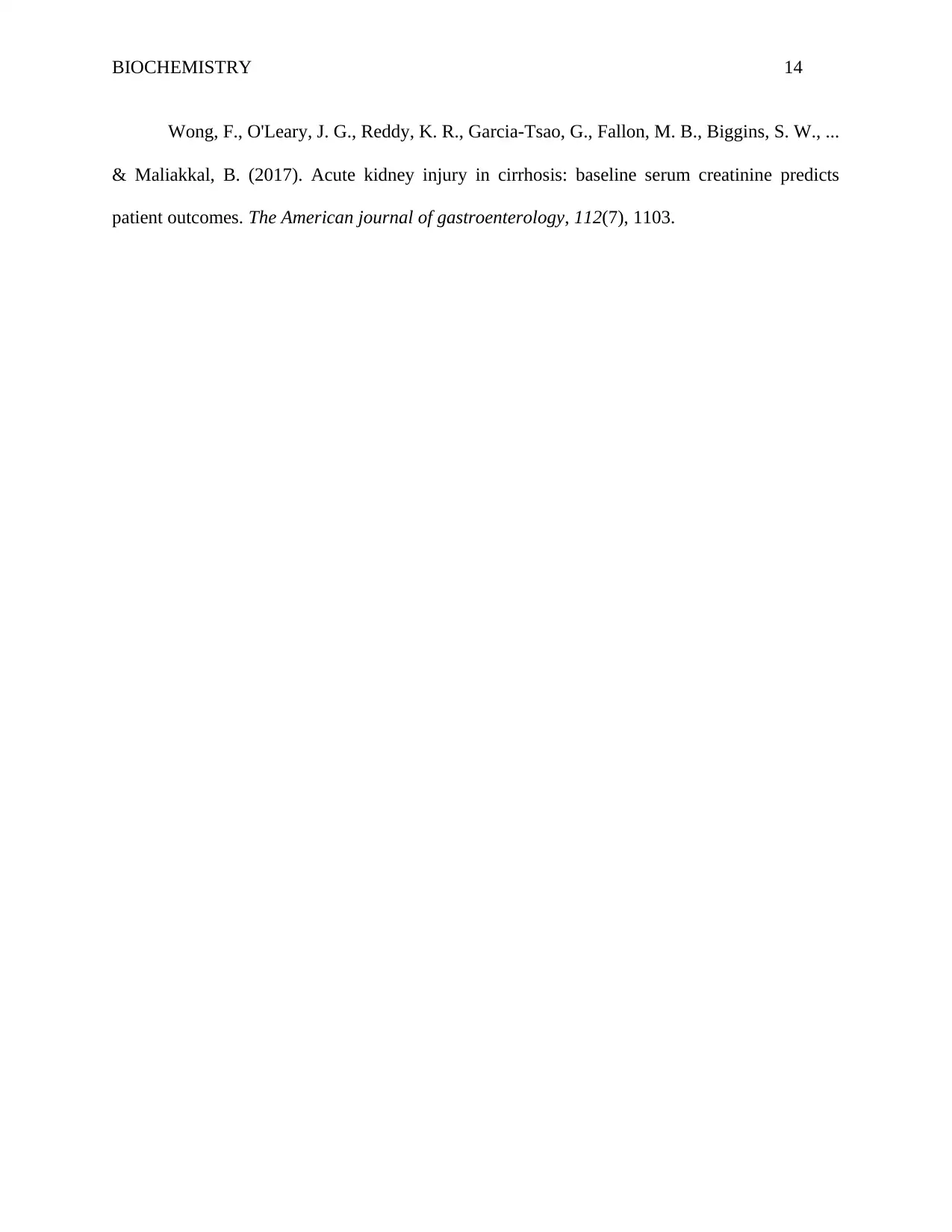
BIOCHEMISTRY 14
Wong, F., O'Leary, J. G., Reddy, K. R., Garcia-Tsao, G., Fallon, M. B., Biggins, S. W., ...
& Maliakkal, B. (2017). Acute kidney injury in cirrhosis: baseline serum creatinine predicts
patient outcomes. The American journal of gastroenterology, 112(7), 1103.
Wong, F., O'Leary, J. G., Reddy, K. R., Garcia-Tsao, G., Fallon, M. B., Biggins, S. W., ...
& Maliakkal, B. (2017). Acute kidney injury in cirrhosis: baseline serum creatinine predicts
patient outcomes. The American journal of gastroenterology, 112(7), 1103.
1 out of 14
Related Documents
Your All-in-One AI-Powered Toolkit for Academic Success.
+13062052269
info@desklib.com
Available 24*7 on WhatsApp / Email
![[object Object]](/_next/static/media/star-bottom.7253800d.svg)
Unlock your academic potential
© 2024 | Zucol Services PVT LTD | All rights reserved.





